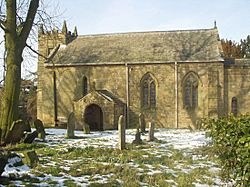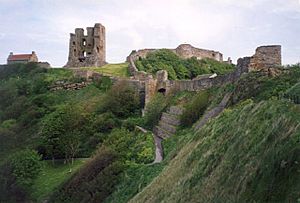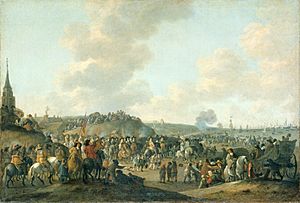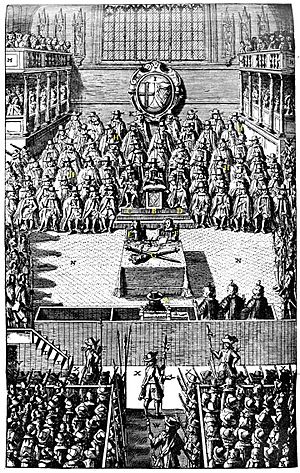Francis Lascelles facts for kids
Quick facts for kids
Francis Lascelles
|
|
|---|---|

St Lawrence, Kirby Sigston, where Francis was buried
|
|
| MP for Northallerton | |
| In office April 1660 – June 1660 resigned |
|
| MP for Yorkshire & North Riding | |
| In office September 1654 – February 1658 |
|
| Nominee for Yorkshire | |
| In office July 1653 – December 1653 |
|
| MP for Thirsk | |
| In office 1645 – April 1653 |
|
| Personal details | |
| Born | 23 August 1612 (baptised) Stank Hall, nr Kirby Sigston Yorkshire |
| Died | 25 November 1667 (aged 55) Kirby Sigston |
| Resting place | St Lawrence, Kirby Sigston |
| Nationality | English |
| Spouses | Frances, 1626-1658 † |
| Children | Elizabeth (1640-1694), Daniel (1655-1734) |
| Parents | William Lascelles (died 1624) Elizabeth Wadeson (died 1647) |
| Residence | Stank Hall |
| Alma mater | Gray's Inn 1629 |
| Occupation | Politician, businessman and soldier |
Francis Lascelles (1612-1667) was an English politician, soldier, and businessman. He fought for Parliament during the Wars of the Three Kingdoms (1639-1652). He served as a Member of Parliament (MP) from 1645 to 1660.
Francis Lascelles was one of the MPs who kept their seat after Pride's Purge in December 1648. He was chosen to be part of the group that tried King Charles I in 1649. However, he did not sign the order for the king's death. Because of this, he mostly avoided severe punishment after the king's return in 1660, known as the Restoration. He was fined and could not hold public office anymore.
In 1662, he was wrongly accused of being part of a plot called the 'Lascelles Plot.' This plot was made up by government spies. Francis Lascelles died at his home in November 1667.
Contents
Francis Lascelles' Early Life
The Lascelles family was well-known in Yorkshire, England. They were also involved in trade and business in places like London, Ireland, New England, and Barbados. Francis Lascelles was born in August 1612 at Stank Hall, near Northallerton. He was the oldest son of William Lascelles and Elizabeth Wadeson.
Francis married Frances St Quentin in 1626. They had many children, but only two lived longer than their parents: Elizabeth (1640-1694) and Daniel (1655-1734). Francis Lascelles passed away at his home in November 1667. He was buried in the local church of St Lawrence.
Francis Lascelles' Role in Politics and War

Like many of his family and friends, Francis Lascelles supported Parliament during the Wars of the Three Kingdoms (1639-1652). These wars were a series of conflicts across England, Scotland, and Ireland. Francis and his brothers, Thomas and Peregrine, helped Parliament raise money and soldiers in Yorkshire. He also signed the Solemn League and Covenant in 1643, which was an agreement to support Parliament.
At the start of the First English Civil War in 1642, many people on both sides were related. This made them hesitant to start fighting. For example, Thomas Fairfax, a Parliamentarian leader, made a peace agreement with a Royalist group. However, Francis Lascelles and other Parliament supporters disagreed with this. Francis later became a Member of Parliament for Thirsk in 1645.
Fighting in the Civil War
When the Second English Civil War began in 1648, Francis was a colonel in the army. He played an important part in the campaign that led to the Royalist army's defeat at the Battle of Preston in August. After this, he joined the forces that surrounded Scarborough Castle. This castle was a vital port in northern England. It changed hands seven times during the wars.
The Parliamentarian soldiers guarding the castle switched sides because they weren't paid. They also got help from Royalist soldiers. When the castle finally gave up in December, some of the foreign soldiers were executed.
The English Civil War caused many deaths. After 1648, Parliamentarian leaders like Oliver Cromwell believed King Charles I could not be trusted. They thought his death was the only way to end the conflict. Francis Lascelles was chosen to be a judge for the king's trial. He was part of a group of senior military officers.
Out of 135 chosen judges, only 68 attended the trial. Francis Lascelles was one of them. However, he was not there when the king was sentenced. He also did not sign the order for the king's death. This decision was very important later on. King Charles I was executed on January 30, 1649.
After the King's Execution
After the king's death, Francis Lascelles took part in Cromwell's invasion of Ireland. In 1642, a law called the Adventurers' Act was passed. This law raised money for an army to stop a rebellion in Ireland. The money was repaid by taking land from Irish rebels. Enforcing this law was a main goal of Cromwell's invasion.
Francis Lascelles likely had business interests in Ireland. He and his brother Thomas had business in Ulster. A part of their family also lived in Killough, County Down.
Francis Lascelles kept his seat as MP for Thirsk after Pride's Purge in December 1648. When the Rump Parliament was closed in April 1653, he was one of 140 members chosen for the Barebones Parliament. This Parliament was in power from July to December 1653. When elections returned in 1654, he became an MP for Yorkshire & North Riding. He served in the First Protectorate Parliament and the Second Protectorate Parliament.
The Restoration and Later Life
When Oliver Cromwell died in 1659, his son Richard took over. But Richard could not govern well. Francis Lascelles was one of the people who talked with General George Monck about bringing the king back. The Commonwealth government ended in 1660. Charles II returned to the throne in an event called the Restoration.

In April 1660, Francis and his brother Thomas were elected MPs for Northallerton. However, in July, they gave up their seats and went to the Dutch Republic. This was because Francis was considered someone who had been involved in the king's trial. Many people involved in the king's trial were severely punished. Francis avoided this because he wasn't present when the king was sentenced. Also, the government became worried about how the public reacted to the punishments.
The Lascelles family was later pardoned and allowed to return home. Francis was fined and was not allowed to hold public office ever again. In December 1662, he was accused of being part of the 'Lascelles Plot.' This was a made-up story by government spies. The real uprising in 1663 quickly failed. Francis Lascelles died at Stank Hall in November 1667.
Images for kids



